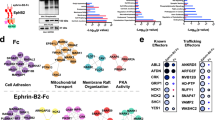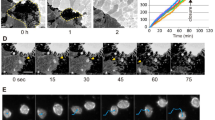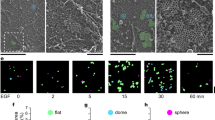Abstract
Eph receptors and their membrane-associated ephrin ligands mediate cell–cell repulsion to guide migrating cells and axons. Repulsion requires that the ligand–receptor complex be removed from the cell surface, for example by proteolytic processing of the ephrin ectodomain. Here we show that cell contact-induced EphB–ephrinB complexes are rapidly endocytosed during the retraction of cells and neuronal growth cones. Endocytosis occurs in a bi-directional manner that comprises of full-length receptor and ligand complexes. Endocytosis is sufficient to promote cell detachment and seems necessary for axon withdrawal during growth cone collapse. Here, we show a mechanism for the termination of adhesion and the promotion of cell repulsion after intercellular (trans) interaction between two transmembrane proteins.
This is a preview of subscription content, access via your institution
Access options
Subscribe to this journal
Receive 12 print issues and online access
$209.00 per year
only $17.42 per issue
Buy this article
- Purchase on Springer Link
- Instant access to full article PDF
Prices may be subject to local taxes which are calculated during checkout







Similar content being viewed by others
References
Dickson, B.J. Molecular mechanisms of axon guidance. Science 298, 1959–1964 (2002).
Hattori, M., Osterfield, M. & Flanagan, J.G. Regulated cleavage of a contact-mediated axon repellent. Science 289, 1360–1365 (2000).
Gao, P.P. et al. Regulation of thalamic neurite outgrowth by the Eph ligand ephrin-A5: implications in the development of thalamocortical projections. Proc. Natl Acad. Sci. USA 95, 5329–5334 (1998).
Jurney, W.M., Gallo, G., Letourneau, P.C. & McLoon, S.C. Rac1-mediated endocytosis during ephrin-A2- and semaphorin 3A-induced growth cone collapse. J. Neurosci. 22, 6019–6028 (2002).
Fournier, A.E. et al. Semaphorin3A enhances endocytosis at sites of receptor-F-actin colocalization during growth cone collapse. J. Cell Biol. 149, 411–422 (2000).
Palmer, A. & Klein, R. Multiple roles of ephrins in morphogenesis, neuronal networking, and brain function. Genes Dev. 17, 1429–1450 (2003).
Harder, T., Scheiffele, P., Verkade, P. & Simons, K. Lipid domain structure of the plasma membrane revealed by patching of membrane components. J. Cell Biol. 141, 929–942 (1998).
Palmer, A. et al. EphrinB phosphorylation and reverse signaling: regulation by Src kinases and PTP-BL phosphatase. Mol. Cell 9, 725–737 (2002).
Grunwald, I.C. et al. Kinase-independent requirement of EphB2 receptors in hippocampal synaptic plasticity. Neuron 32, 1027–1040 (2001).
Kullander, K. et al. Kinase-dependent and kinase-independent functions of EphA4 receptors in major axon tract formation in vivo. Neuron 29, 73–84 (2001).
Brambilla, R. et al. Similarities and differences in the way transmembrane-type ligands interact with the Elk subclass of Eph receptors. Mol. Cell Neurosci. 8, 199–209 (1996).
Shamah, S.M. et al. EphA receptors regulate growth cone dynamics through the novel guanine nucleotide exchange factor ephexin. Cell 105, 233–244 (2001).
Dalva, M.B. et al. EphB receptors interact with NMDA receptors and regulate excitatory synapse formation. Cell 103, 945–956 (2000).
Sorkin, A. & Von Zastrow, M. Signal transduction and endocytosis: close encounters of many kinds. Nature Rev. Mol. Cell Biol. 3, 600–614 (2002).
Cagan, R.L., Kramer, H., Hart, A.C. & Zipursky, S.L. The bride of sevenless and sevenless interaction: internalization of a transmembrane ligand. Cell 69, 393–399 (1992).
Incardona, J.P. et al. Receptor-mediated endocytosis of soluble and membrane-tethered Sonic hedgehog by Patched-1. Proc. Natl Acad. Sci. USA 97, 12044–12049 (2000).
Parks, A.L., Klueg, K.M., Stout, J.R. & Muskavitch, M.A. Ligand endocytosis drives receptor dissociation and activation in the Notch pathway. Development 127, 1373–1385 (2000).
Mann, F., Miranda, E., Weinl, C., Harmer, E. and Holt, C.E. B-type Eph receptors and ephrins induce growth cone collapse through distinct intracellular pathways. J. Neurobiology (in the press).
Qualmann, B. & Kessels, M.M. Endocytosis and the cytoskeleton. Int. Rev. Cytol. 220, 93–144 (2002).
Chimini, G. & Chavrier, P. Function of Rho family proteins in actin dynamics during phagocytosis and engulfment. Nature Cell Biol. 2, E191–196 (2000).
Nichols, B.J. & Lippincott-Schwartz, J. Endocytosis without clathrin coats. Trends Cell Biol. 11, 406–412 (2001).
Burke, P., Schooler, K. & Wiley, H.S. Regulation of epidermal growth factor receptor signaling by endocytosis and intracellular trafficking. Mol. Biol. Cell. 12, 1897–1910 (2001).
Barker, P.A., Hussain, N.K. & McPherson, P.S. Retrograde signaling by the neurotrophins follows a well-worn trk. Trends Neurosci. 25, 379–381 (2002).
Bruckner, K. et al. EphrinB ligands recruit GRIP family PDZ adaptor proteins into raft membrane microdomains. Neuron 22, 511–524 (1999).
Sambrook, J., Fritsch, E.F. & Maniatis, T. Molecular Cloning: A Laboratory Manual, (Cold Spring Harbour Lab. Press, Plainview, NY, 1989).
Kullander, K. et al. Ephrin-B3 is the midline barrier that prevents corticospinal tract axons from recrossing, allowing for unilateral motor control. Genes Dev. 15, 877–888 (2001).
Marston, D.J., Dickinson, S. & Nobes, C.D. Rac-dependent trans-endocytosis of ephrinBs regulates Eph–ephrin contact repulsion. Nature Cell Biol. 5, DOI: 10.1038/1044 (2003).
Acknowledgements
We thank A. Weiss, T. Schwickert, L. Peters and C. König for experimental help. We also thank M. Osterfield, J.G. Flanagan, M. Dalva and M.E. Greenberg for providing reagents, and I.C. Grunwald, G.A. Wilkinson, F. Helmbacher and F. Bradke for critically reading the manuscript. We thank M. Zerial for helpful discussions. This work was funded in part by grants from the Deutsche Forschungsgemeinschaft.
Author information
Authors and Affiliations
Corresponding author
Ethics declarations
Competing interests
The authors declare no competing financial interests.
Rights and permissions
About this article
Cite this article
Zimmer, M., Palmer, A., Köhler, J. et al. EphB–ephrinB bi-directional endocytosis terminates adhesion allowing contact mediated repulsion. Nat Cell Biol 5, 869–878 (2003). https://doi.org/10.1038/ncb1045
Received:
Accepted:
Published:
Issue Date:
DOI: https://doi.org/10.1038/ncb1045
This article is cited by
-
Ephrin-B2–EphB4 communication mediates tumor–endothelial cell interactions during hematogenous spread to spinal bone in a melanoma metastasis model
Oncogene (2020)
-
The endosomal sorting adaptor HD-PTP is required for ephrin-B:EphB signalling in cellular collapse and spinal motor axon guidance
Scientific Reports (2019)
-
Ephrin-A5 potentiates netrin-1 axon guidance by enhancing Neogenin availability
Scientific Reports (2019)
-
TBC1d24-ephrinB2 interaction regulates contact inhibition of locomotion in neural crest cell migration
Nature Communications (2018)
-
Long-lived force patterns and deformation waves at repulsive epithelial boundaries
Nature Materials (2017)



